Vol 4 No. 44 TROPIC LIGHTNING NEWS November 3, 1969
Index
Allies Evict VC-NVA from Nui Ba Den
| When five Allied infantry units moved out as the hard core of a three-day operation on Nui Ba Den, two Tropic Lightning combat correspondents, Specialist 4 K.C. Cullen of the 3d Battalion, 22d Infantry and Specialist 5 Carl Detrick of the 2d Battalion, 34th Armor were with their units. This is their report of the action. |
TAY NINH
- A daring, well-coordinated and powerful Allied force yesterday ended three
days of reminding the enemy soldiers who insist on their Nui Ba Den squatters'
rights that the high-rise living on the mountain is neither cheap nor
comfortable.
Rent-paying for 40 NVA-VC soldiers ended during the 72 hours of Operation
Cliffdweller, as artillery and gunships complemented the digging work of five
infantry units that made up Task Force Jones.
JONES' MAIN men were the Regulars of the 3d
Battalion, 22d Infantry, bolstered by Company A of the 2d Battalion, 34th Armor,
Company B of the 4th Battalion (Mechanized), 23d Infantry and two Vietnamese
units, the 160th Regional Force Company and a provincial reconnaissance element.
The operation, a direct challenge to what remained of enemy claims on control
of the mountain, found Allied infantrymen going down from the top and coming up
from the bottom. Meanwhile, artillery and air support rained down from all
directions on the harassed enemy.
While the 2/34 Dreadnaughts' armor and the RF company soldiers set up
blocking forces around the base of the mountain, the 187th Assault Helicopter
Company Crusaders dropped the Regulars' B Company on the top of auxiliary peak
Nui Cau to secure that area.
The 3/22 Delta Company drew the job of struggling up the side of the mountain
to occupy the Pagoda area, while the Regulars' C Company and the Vietnamese
recon unit started down from the top after being dropped at the Allied signal
facility there by chinook.
When movement was spotted near the Regular-RF defensive position the first
night, half the world fell in on the enemy soldiers. Twice during the night,
the RF soldiers ventured out to sweep the movement area, and the second time
they met no resistance.
When morning came, they found 20 enemy bodies, plus a collection of AK-47
assault rifles and armed, unused RPG-7s.
DURING THE next two days, the Regular-RF force
scoured the mountainside, a challenge even to a mountain goat, during the day
and stayed alert at night. It accounted for two more enemy dead in a skirmish
near a cave that hid a cache of medical supplies, clothing and food.
The Regulars' Delta Company, meanwhile, used the Pagoda as a base and roamed
the surrounding area, despite harassment by enemy snipers. The Tropic Lightning
unit killed four NVA near one cache, and eliminated five more during the
sporadic clashes among the rocks and brush of the craggy slopes.
The Cobra gunships of the D Troop, 3d Squadron, 4th Cavalry and B Company,
25th Aviation Battalion, providing continuing support for the ground troops
during the operation, were credited with another nine enemy killed.
Regular Commander Lieutenant Colonel Warren A. Jones of Minneapolis called
Cliffdweller "an unqualified success."
"Besides the obvious military victory, the psychological victory of occupying
an area the enemy considered to be his and his alone was enormous," Jones said.
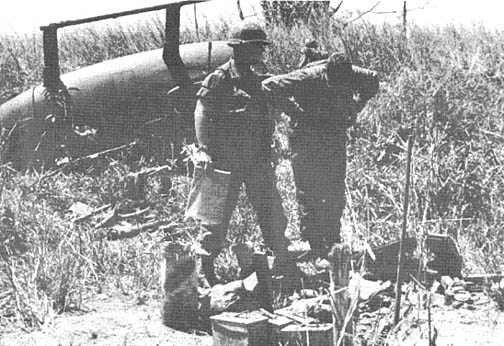 |
| THEY WENT THATAWAY - Lieutenant Colonel Donald O. Crutchley of Bethesda, Md., 2d Battalion, 14th Infantry commander, and a 3d Squadron, 4th Cavalry officer look over a cache found when a 3/4 Cav LOH was shot down and its crew had to battle out of trouble. Story on page 8. (PHOTO BY 5P4 FRANK DITTO) |
Hounds' Bite Bad As Bark
PHUOC LUU - Second Battalion Wolfhounds
supported by ten air strikes and a Centaur helicopter team killed 18 enemy
during a rare daylight contact in the area surrounding this 3d Brigade border
outpost.
The enemy were believed to be part of a 200-man force that moved into the
area from nearby Cambodia. They were supported by .51 caliber machinegun
positions about 2,000 meters from the battle site inside Cambodia.
First contact came after the enemy was spotted moving along a road near the
border. One platoon of Alpha Company and two platoons of Delta Company, 2d
Battalion, 27th Infantry, were sent to find the enemy and made contact about 500
meters west of Phuoc Luu.
The Wolfhounds engaged the enemy force with small arms as a light fire team
and air strikes were directed at enemy positions by Air Force forward air
controllers.
F-100 jets and gunships from Delta Troop, 3d Squadron, 4th Cavalry remained
in the area throughout the day. Both were subjected to enemy .51 caliber
machinegun fire.
One detainee was taken, four bunkers were destroyed and two AK-47 rifles were
captured in addition to the 18 enemy killed during the battle.
Take Tons of Concentrated Firepower,
Mix into Mushroom; Serves 47 NVA
CU CHI - Warriors of Alpha Company broke a major
enemy concentration late this evening in a fierce four-hour battle in The
Mushroom area 15 miles north of Cu Chi. Forty-seven enemy died in the action.
The 2d Battalion, 12th Infantry soldiers encountered enemy small arms fire in
late afternoon after they had been airlifted into a nearby cul-de-sac formed by
the Saigon River, just north of the Ho Bo Woods.
As the Warriors pushed through the fringes of the heavily cratered woods
toward the river, they began receiving AK fire from its swampy banks. Laying
down a heavy cover of automatic weapons fire, the Tropic Lightning troops called
for artillery and air support.
FROM FIRE Support Base Pershing, 105mm howitzers
of the 1st Battalion, 8th Artillery launched the first barrage. They were
joined seconds later by batteries of the 3d Battalion, 13th Artillery at FSB
Patton II and FSB Hampton.
Forward Air Controllers of the Division's ISSUE Tactical Air Control Party
dove into the area, their armed OV-10 Broncos firing both rockets and
machineguns.
For 30 minutes ordnance fell on the enemy positions. Then the Warriors,
augmented now by elements of their Bravo Company, drove in for what they
expected to be a routine after-action sweep.
BUT THE ACTION wasn't over, and it was no
sweep. Private First Class Ernesto Gonzales of Freer, Tex., described it this
way:
"Standing there watching the air strike go in, I didn't think there would be
anything in there left alive. But there was. They hardly fired at all at
first, until we got right on top of them. Then they started coming out of the
ground everywhere. There were VC behind us, in front of us and on the sides as
well. All we could do was grab our casualties and shoot our way out."
With no bunkers or fighting positions left, the NVA dashed from bomb crater
to tree stump, firing at times from only meters away from the Americans.
(Continued' on Page 8)
VC's View of War: No Mail, No DEROS, No
Hope
By 2LT ARTHUR E. CERF JR.
CU CHI - Top sergeant got you down? That
lieutenant jumping all over you? Tired of C-rations, sweat and the tedium of it
all?
Well, take a close look at what the other side is going through.
A recent pair of hot chanhs-a reluctant VC grunt and a Hanoi-trained VC
captain-gave these accounts of what they experienced while living with the
enemy:
Nguyen Van Tri, a farmer and family man who lived near Trang Bang, was
inducted into the VC in 1967 at gunpoint. (His name has been changed here to
protect his family from reprisals.) Along with a number of other "volunteers,"
he was marched into Cambodia for training.
For more than a year he studied tactics, political theory and bunker
building. (Tri, not being the most apt pupil, filled a lot of sandbags.)
RIFLE TRAINING started with a three-week
orientation using a wooden AK-47. After this phase, Tri and 80 other trainees
tromped out to a practice range with two real rifles for the group and two
bullets per man.
If a novice marksman hit the target on the first try, he was made
an instructor. If he missed with both rounds, he had to go through the whole
course again. (Tri was re-cycled three times. He blamed his problem on the
weight disparity between the real and wooden rifles.)
(Continued on Page 8)
| If you've been thinking about the war and asking yourself, "Is that all there is?" the answer is no. Look elsewhere on this page, ask someone at Tay Ninh base camp - it's not over yet. Stay alert and DEROS. Do it the safe way. |
Page 2 TROPIC LIGHTNING NEWS November 3, 1969
Decorated
| SILVER STAR | |
|
1LT Danny E. Mull, E Co., 2d Bn, 12th Inf SSG Jon M. Davis, C Co, 2d Bn, 14th Inf |
SGT John P. Fee, B Co, 2d Bn, 14th Inf |
| DISTINGUISHED FLYING CROSS |
|
|
WO1 Eric G. Brethen, D Co, 3d Sqdn, 4th Cav SP4 Charles Carmel, A Co, 25th Avn Bn |
SP4 Kenneth E. Taylor, D Co., 3d Sqdn, 4th Cav |
| SOLDIER'S MEDAL |
|
| SSG Marcus C. Fisher, HHC, 2d Bn, 34th Armor | SP4 Charles W. Lovell, 390 Quartermaster Det. |
|
BRONZE STAR FOR HEROISM |
|
|
CPT Edwin Chappabitty, HHB, 3d Bn, 13th Arty 1LT John H. Lowe, A Btry, 7th Bn, 11th Arty 1LT John D. Revier, HHC, 4th Bn, 23d Inf 2LT William R. Hyder, D Co, 1st Bn, 27th Inf 2LT Terrence N. O'Connell, D Co, 2d Bn, 34th Armor, 2LT Michael P. Pater, A Co, 2d Bn, 34th Armor, (two simultaneous awards of B.S. w/"V") 1SG Floyd English, B Co, 2d Bn, 22d Inf PSG Clinton Russell, B Co, 2d Bn, 22d Inf PSG Richard W. Stinchcomb, A Co, 2d Bn, 34th Armor SSG John D. Burch, HHC, 4th Bn, 23d Inf SSG Donald L. Calhoun, D Co, 2d Bn, 22d Inf SSG Charles E. Hawes, A Co, 2d Bn, 34th Armor SSG Dan L. Helms, A Co, 2d Bn, 34th Armor SSG Issac Jacobs, B Co, 2d Bn, 22d Inf SGT Perry W. Basham, HHC, 4th Bn, 23d Inf SGT William C. Davis, B Co, 2d Bn, 22d Inf SGT William M. Battle, D Co. 1st 27th Inf SGT Robert S. Burns, B Co, 3d Bn, 22d Inf SGT Thomas Eagle, A Co, 2d Bn, 34th Armor SGT Gary P. Hershberger, A Co, 2d Bn, 34th Armor SGT William C. Skidmore, A Co, 2d Bn, 34th Armor SGT Victor S. Stanley, A Co, 2d Bn, 34th Armor SP5 Bruce J. Rose, A Co, 2d Bn, 34th Armor SP5 Richard E. Whitely, D Co, 2d Bn 22d Inf SP4 Roy Blevins, HHC, 4th Bn, 23d Inf SP4 Willie L. Brown, B Co, 2d Bn, 22d Inf SP4 Walter L. Dalton, C Co, 3d Bn, 13th Arty SP4 Andrew Diffily, D Co, 2d Bn, 22d Inf |
SP4 Grosvenor C. Hanlin, B Co, 2d Bn, 22d Inf SP4 Noe Hinojosa, B Co, 2d Bn, 22d Inf SP4 Robert Hunt, A Co, 1st Bn, 5th Inf SP4 Michael J. Irvine, B Co, 2d Bn, 22d Inf SP4 Charles Jones, E Co, 2d Bn, 12th Inf SP4 Lawrence V. Kassanavoid, B Co, 2d Bn, 22d Inf SP4 Thomas E. Langenburg, C Co, 1st Bn, 5th Inf SP4 Joseph J. Masa, B Co, 2d Bn, 22d Inf SP4 Wayne Miskimen, D Co, 2d Bn, 12th Inf SP4 John A. Morgan, A Co, 2d Bn, 34th Armor SP4 Stephen Murphy, B Co, 2d Bn, 22d Inf SP4 Daryl V. Orr, HHC, 2d Bn, 12th Inf SP4 Will D. Parks, A Co, Bn, 34th Armor SP4 Moody C. Pitts, D Co, 2d Bn, 22d Inf SP4 Ronald B. Poston, E Co, 2d Bn, 12th Inf SP4 Lloyd L. Rassat, HHC, 1st Bn, 27th Inf SP4 Francisco San Nicolas, D Co, 1st Bn, 27th Inf SP4 Robert I. Sechi, B Co, 2d Bn, 22d Inf SP4 Robert S. Webb, E Co, 1st Bn, 27th Inf SP4 Jack R. Williams, B Co, 2d Bn, 22d Inf PFC Gregory E. Hall, E Co, 1st Bn, 27th Inf PFC Gary L. Holloway, D Co, 2d Bn, 12th Inf PFC George A. Huffstutler, D Co, 2d Bn, 12th Inf PFC Charles P. Humphrey, D Co, 2d Bn, 12th Inf PFC Won H. Kim, B Co, 2d Bn, 12th Inf PFC Gary L. Reeves, B Co, 3d Bn. 22d Inf PFC Gregory T. Stoicheff, D Co, 1st Bn, 27th Inf PFC David Vines, D Co, 1st Bn, 27th Inf PFC Henry G. Zudowski, B Co, 2d Bn, 22d Inf |
TROPIC LIGHTNING
Combat Honor Roll
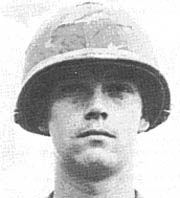 Sergeant Walter E. Lausman of Company A, 2d Battalion, 12th Infantry
Warriors, has been added to the Tropic Lightning Combat Honor Roll.
Sergeant Walter E. Lausman of Company A, 2d Battalion, 12th Infantry
Warriors, has been added to the Tropic Lightning Combat Honor Roll.
Lausman was serving as a squad leader on a reconnaissance mission when his
company came in contact with a large enemy force in well-fortified positions.
During the initial burst of fire, the point man from the Warriors' lead
element was seriously wounded; lying in an open position well forward of the
rest of the unit.
Lausman, defying a deadly barrage of fire directed at him, rushed to within
20 feet of the enemy bunkers and began putting out a heavy volume of fire while
his unit moved to cover.
Although fully exposed to the enemy gunners, Lausman then moved to the side
of his fallen comrade and administered first aid. He picked up the wounded man
and carried him through the embattled area to a sheltered spot, despite the
continuing hostile fire.
Tropic Lightning Tots
The Commanding General Welcomes
The Following Tropic Lightning Tots
To The 25th Infantry Division – As
Reported By The American Red Cross.
Born To:
| PFC Harvey
McConaughead, A 4/9, girl, Oct 4 MAJ David C. Kiger, HHC 4/23, boy, Oct 7 SGT Ray Thomason, A 65th Engrs, boy, Oct 10 PVT Thomas D. Konen, A 4/9, girl, Oct 11 SP4 Roosevelt Scott, A 1/27, girl, Oct 12 SP4 Ronald D. Watkins, 548th Mnt, girl, Oct 14 PFC Joseph Parisi, B 3/4, girl, Oct 15 SP4 Ernest Primas, A 25th Avn, boy, Oct 15 |
Dentists Fill Role Of Tooth Savers
Charlie doesn't care, it's true, if all your teeth fall out and all you can
eat is reconstituted applesauce.
But the Army cares, and has sent the dental personnel of the 44th Medical
Brigade to Vietnam to make sure you return to the world with the same pearly
white smile you had when you left.
If your teeth are in good shape now, brush them regularly and they will stay
that way, the dentists say. But if you need some dental work, their dental
clinics and mobile teams provide complete care ranging from oral surgery to
replacement of missing teeth in facilities that go from tents up to
air-conditioned buildings as well-equipped as any stateside dentist's office.
"The only limitation we have on providing dental care is time," says
Lieutenant Colonel Allen Betts, clinic chief of the 137th Medical Detachment.
"The patient should have 30 days left in-country in case follow-up work is
needed."
Most of the dental problems affecting troops are routine decay and
non-restorable teeth.
"The reason for losing teeth after age 25 is usually gum problems, which can
be prevented by frequent brushing," Betts says. "Out in the boonies the main
dental problem is just keeping one's mouth clean; even brushing with just a dry
toothbrush reduces decay significantly."
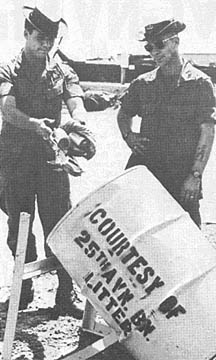 |
HELP KEEP CU CHI CLEAN - Warrant Officer Robert Miller (right) of the 25th Aviation Battalion watches as Specialist 4 George Thomas throws the first handful of trash into a new road-side litter barrel. Miller directed a battalion project to set up litter barrels to keep 25th Aviation's area at Cu Chi clean. Setting the barrels up, Miller said, was easy. "The hardest part is getting people to use them." (PHOTO BY SP4 GREG TELLE) |
Life Assurance
Nearly all soldiers separated from the Army with a less than honorable
discharge are "unable to overcome a civilian life of failure and insecurity,"
Federal government studies show.
Those who receive a dishonorable or bad conduct discharge are not eligible
for most benefits administered by the Army, the Veterans administration and
other Federal agencies for the rest of their lives, according to the Department
of the Army.
Only a small percentage of petitions to change less than honorable discharges
is allowed by the Army Discharge Review Board, DA adds.
Only You Can Prevent Duds
(ANF) - Qualified soldiers in grades E4 through E7 are encouraged to
volunteer for drill sergeant assignments.
As of July 31, the Army was short 2,558 drill sergeants or almost 30 per cent
of total authorization. This shortage has forced greater workloads on those
currently performing this duty.
Drill sergeants receive $30 per month superior performance pay, extra
uniforms and free laundry for fatigues. They generally are stabilized for an
18-month tour or until completion of 24 months in CONUS, whichever comes first.
Drill sergeants may be promoted to grade E6 for outstanding performance of
duty or for being the top graduate at drill sergeant school.
Consult AR 614-204 for additional information.
The TROPIC LIGHTNING NEWS is an authorized publication of the 25th Infantry Division. It is published weekly for all division units in the Republic of Vietnam by the Information Office, 25th Infantry Division, APO San Francisco 96225. Army News Features, Army Photo Features, Armed Forces Press Service and Armed Forces News Bureau material are used. Views and opinions expressed are not necessarily those of the Department of the Army. Printed in Tokyo, Japan, by Pacific Stars and Stripes.
MG Harris W. Hollis . . . . . . . Commanding General
MAJ Warren J Field . . . . . . Information Officer
1LT John C. Burns . . . . . . . . Officer-in-Charge
SP4 Ralph Novak . . . . . . . . . Editor
SP4 Harold O. Anderson . . Assistant Editor
SGT John Genitti. . . . . . . . . . Production Supervisor
BATTALION CORRESPONDENTS
| SP4 Dennis Bries SP4 Bill Frame SGT Bill Obelholzer SP4 Larry Goodson PFC Jim Williams PFC Richard Sears SP4 Carl Detrick Wally Baker SP4 Frank Ditto PFC Greg Stanmar SP4 Phil Jackson SP4 Pat Morrison |
2/22 4/23 4/23 2/12 2/12 4/9 2/34 2/34 2/14 2/14 2/27 3/13 |
SP4 Ken Baron SP5 Tony DeBlasio PFC Rich Fitzpatrick SP4 Ken Fairman SP4 Brad Yeager PFC Frank Rebbonico PFC Doug Sainsbury PFC Richard Fitzpatrick SGT Larry Goodson SP4 K.C.Cullen SP4 Tony Crawford SP5 Pete Freeman SP4 Craig Sampson |
1/8 2/12 1/5 DIVARTY 1/27 1/27 2/27 1/5 2/12 3/22 4/9 7/11 2/27 |
Page 3 TROPIC LIGHTNING NEWS November 3, 1969
Enemy Infiltration Stifled:
2d
Wolfhounds Keep Watch on Border
By SP4 PHIL JACKSON
CU CHI - "Almost every night I can see a long
stream of convoy lights pass just on the side of the border. It scares the hell
out of me to actually watch an enemy convoy in Cambodia so near to this
outpost."
Specialist 4 Gordon Maga made the comment as he took his position behind a
.50 caliber machine gun outside Phuoc Luu village less than 3000 meters from an
enemy staging area in Cambodia.
Each night Maga and soldiers like him in the 2d Battalion, 27th Infantry
Wolfhounds take up positions at Phuoc Luu and Patrol Base Kotrc, another outpost
a mile and a half southeast. Their job is to plug infiltration routes into Hau
Nghia Province.
"The tip of the Angel's Wing to An Ninh village has in the past been a prime
infiltration route for the NVA wishing to pass from Cambodia to Saigon and the
Citadel area," said 2d Battalion Wolfhound S-3, Major Frank Leach of Manteca,
Calif.
FOR THIS reason, the 3d Brigade Wolfhounds
during Tet and again recently, established forward patrol bases close to the
border.
In February the Hounds began the first of four patrol bases called Diamond to
check enemy infiltration. The concept was successful in halting the flow of NVA
while inflicting more than 600 enemy casualties. By May enemy activity was so
low in the area that the Wolfhounds tore down the outposts and moved on.
By July, enemy activity west of the Vam Co Dong River picked up. The
increased activity led to two large conflicts between Tropic Lightning forces
and NVA on the western side of the river. Total enemy casualties ran near 200.
The Wolfhounds went west of the river again in August to build a forward
patrol base. An element of Alfa Company was eagle flighted to secure a site and
encountered a reinforced enemy battalion.
Three companies were committed to the battle. Together they routed the enemy
after an assault on the dug-in NVA.
ON THE BATTLE site, the Wolfhounds built Patrol
Base Kotrc, four kilometers east of the border. Shortly after that Bravo
Company joined Popular Forces at their outpost in the nearby village, Phuoc Luu.
"These forward positions are very important to us," Leach said. "Kotrc sits
right in the middle of that infiltration route. Now we are forcing the NVA to
move further south which takes him three times as long to reach the Vam Co Dong
River. Thus, he is exposed longer and it forces his slave laborers to work
three times harder."
"Bravo Company has established good relations with Phuoc Luu villagers,''
continued Leach. "Phuoc Luu is a rich village and because of its proximity to
the border, the VC had been trading extensively there. Also it was a major
recruiting area for the NVA."
"NOW THAT we are forcing the enemy to travel
farther out of his way and since the people no longer cooperate with him, enemy
morale has dropped very low," Leach said. "We have made it easier and more
desirable for the enemy to Chieu Hoi (rally). Fourteen of them rallied to Bravo
Company last week."
At Patrol Base Kotrc, the Wolfhounds and elements of the 1st Battalion, 49th
ARVN Regiment occupy the bunker line. Cannoneers from the 2d Battalion, 77th
Artillery work the big guns inside.
"The two elements depend on each other for survival," said First Lieutenant
Joe Pritchard of Benton, Ark. "The infantry relies on artillery to engage the
enemy far from the perimeter. The artillerymen depend on the infantry when the
enemy gets close, to drive them out if they get inside the wire."
DELTA COMPANY Commander Captain Jay Yurchuck of
Columbus, Ga., commented on the defense of Kotrc, "Survival along the border
involves some of the most sophisticated devices known to modern warfare. Also
coordination between infantry, artillery and aviation are necessary for
successful completion of our mission."
"This patrol base is unique for us in that it was fought for, occupied, and
successfully defended against four enemy probes. Two required us to drive
sappers out of the perimeter and two large ground probes that never made it near
the wire," Yurchuck said.
Radarman Specialist 4 Lonnie Jurgesmeyer of Warrenton, Mo., sums up the
feeling of the men at the border posts. "We man a constant night vigil so we
are aware of enemy movement across the border. At times I wonder what it would
be like to watch girls on the beach instead of my radar controls."
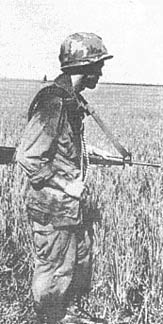 |
SCANNING - A Bravo Company Wolfhound scans the area around Phuoc Luu village during blocking operations near the Cambodian border. |
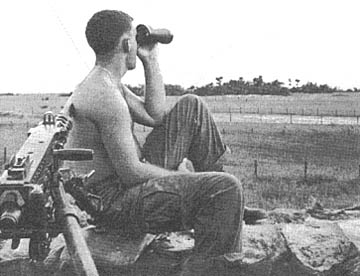 |
| LIFE ALONG THE BORDER - (Top) A Wolfhound keeps a lookout on the perimeter of Patrol Base Kotrc, near a major enemy infiltration route. (Right) Border-dwelling Wolfhounds find that sleep is more secure when you're not far from your 90mm recoilless rifle. (Bottom) A Wolfhound gives a piggyback ride to an ARVN across a deep canal near the border. (Photos by Sp4 Phil Jackson) | 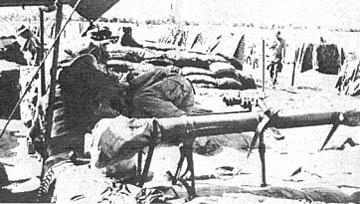 |
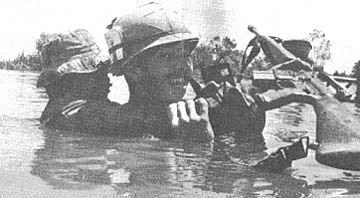 |
Regulars, ARVNs Join, Build 2 Support Bases
By SP4 K. C. CULLEN
TAY NINH - Regulars of the 3d Battalion, 22d
Infantry have been involved in a number of combined operations since the
beginning of 1969, but none has been as extensive as the operation now in
progress with elements of the 2d ARVN Airborne Brigade.
The mission got off to a rousing start with the establishment of Fire Support
Bases Elizabeth and Cathy. These bases, with the Vietnamese paratroopers
guarding the perimeter and manning their own howitzers, were established in two
days with a multi-company force.
Alpha, Charlie and Delta Companies of the Regulars cleared and guarded the
road and area surrounding the new Fire Support Base Elizabeth during the first
phase of the construction. The regulars' "rat pack" reconnaissance platoon and
its gun jeeps escorted the bulldozers and heavy trucks of Alpha Company, 65th
Engineer Battalion to the site.
The initial site of Elizabeth was found unfit as the Whiskey Fifth dozers got
bogged down in a marsh concealed beneath the thin layer of hard ground.
Lieutenant Colonel Lich, commander of the 2d ARVN Airborne Brigade and First
Lieutenant Thomas R. Chapman of Lawton, Okla., of the engineers utilized an LOH
helicopter and located a suitable site at the other end of an old French
airstrip, the major landmark in the area.
As the berm was pushed up, the ARVNs arrived with one of their mechanized
companies leading the trucks. The paratroopers immediately began the essential
construction of bunkers and gun emplacements.
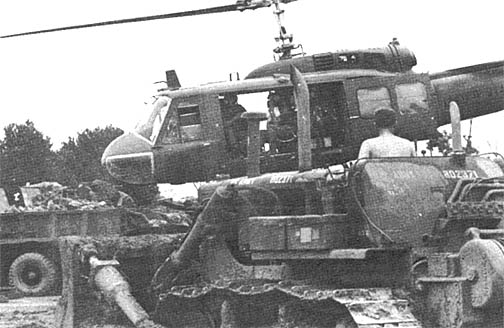 |
| CAT AND BIRD-A Whiskey Fifth bulldozer moves to push up a defensive berm during construction of Fire Support Base Elizabeth as the Regulars' command-and-control helicopter lifts off just to its front. (Photo by Sp4 K. C. Cullen) |
Page 4-5 TROPIC LIGHTNING NEWS November 3, 1969
 |
|
Lao Tao, the Hamlet of New Life |
Dragons Help Villagers Turn VC Terror into
New Life
In August, Le Van Sieng, village chief of Trung Lap, offered a plan of hope
to nearby farmers and hamlets dwellers who were plagued by Viet Cong: Build
yourself a new village and we will protect you.
With help from Golden Dragons of the 2d Battalion, 14th Infantry, men of the
2d Battalion, 49th ARVN Regiment and Trung Lap civil defense cadre, the people
did just that. By mid-October over 50 families had moved into new homes. Most
had been relocated from the villages of So Noi I and So Noi II..
In August, construction of the new hamlet got under way as bulldozers were
brought in to clear a plot of land on the outskirts of Trung Lap.
The "New Life" hamlet of Lao Tao was completed by the new inhabitants. The
Golden Dragons and ARVN Regiment had furnished the materials, but the future
occupants did all the construction and planning themselves.
The new village offered police protection from nearby Trung Lap, and the
danger that civilians might be injured in military operations was eliminated.
Soon after they resettled, the people held a secret ballot election and
elected their own hamlet chief. Battalion surgeon for the Golden Dragons,
Captain Howard M. Hanna, Jr., of San Antonio, Tex., held the village's first
medical civic action program (MEDCAP) more than 100 people were treated.
"Even though we donated the materials along with the 49th ARVN Regiment, the
villagers did all the work and set up their own village. The people worked hard
and are very proud of their new homes," said. Sergeant Anthony Newcomb, Midland,
Mich., of the Golden Dragon S-5 section.
|
Photo Feature By SP4 Frank Ditto |
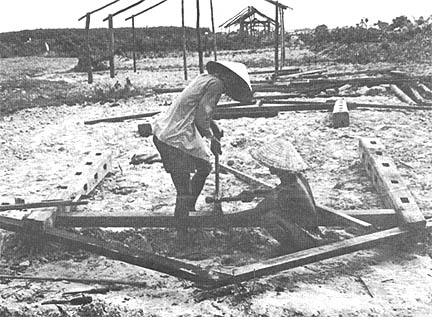 |
| TO BUILD A HAMLET - Farmers and villagers near Trung Lap, long plagued by Viet Cong, took the situation in hand and, with help from the 2d Battalion, 49th ARVN Regiment and Tropic Lightning's 2d Battalion, 14th Infantry, they built a new hamlet, Lao Tao, where they could receive police protection and start new and secure lives. | 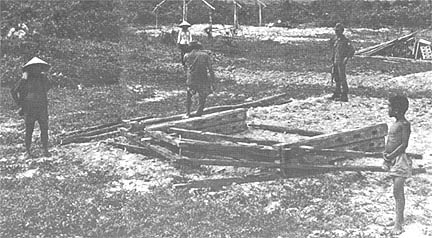 |
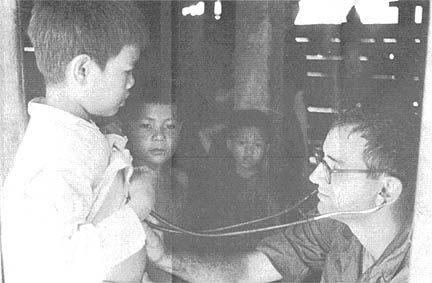 |
A Golden Dragon MEDCAP doctor inspects a young patient. |
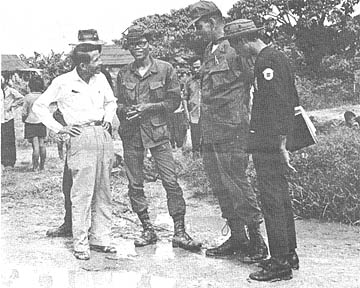 |
TRUNG LAP VILLAGE CHIEF Le Van Sieng discusses the success of the village resettlement program outside the new hamlet of Lao Tao with Lieutenant Colonel Constantine Blastos, former commander of the 2d Battalion, 14th Infantry. The Golden Dragons supplied much of the material for the new hamlet. |
| A new home, a new life, a new smile |
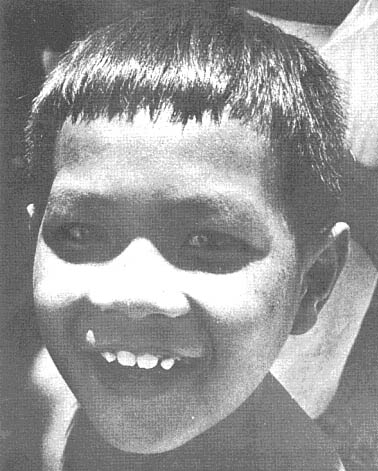 |
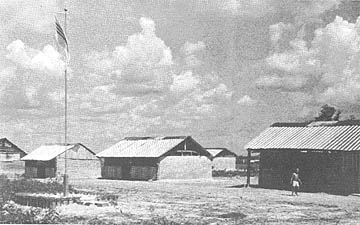 |
PROUDLY FLYING the Republic of Vietnam's flag, villagers at Lao Tao, the Hamlet of New Life, settle down to the tasks of life-minus the constant threat of Viet Cong terror which they had known before. |
Page 6 TROPIC LIGHTNING NEWS November 3, 1969
Engineers Build Fire Support Sub-division
By SGT THOMAS JORGENSON
TAY NINH - When new concepts in fire support
command and control are proposed, Tropic Lightning engineers can be counted upon
to put them into practice.
In direct support of the division's infantry units, the 65th Engineer
Battalion has constructed a new fire support control center in Tay Ninh East.
"IT'S BEEN a big project," said Sergeant First
Class Tommy Alexander of Hartsville, Ind., project NCOIC. "Everyone from MACV
on down is interested in it, and we've had visitors out here every day."
The primary purpose of the project, Alexander said, is to unify and
coordinate artillery and aerial support among all branches of the service
operating in the area. The new fire support center housed in the bunker complex
will have facilities for joint occupation by Army, Air Force and Navy forces in
addition to ARVN troops.
DESPITE HEAVY rains, Alexander's second platoon
from Bravo Company stayed with the project. Before the concrete floor could be
laid, mud had to be scooped up and hauled away from the work site and dry fill
hauled in.
When first notified of the project, welders from the battalion maintenance
section worked all night to cut and drill half-inch steel plates to form
custom-made braces for the bunker beams.
"We've mostly been humping," said Private First Class George A. Bullard of
Whitmire, S.C., as he tightened steel cable used to shore the bunker's heavy
timber supports.
"Over 35 dump trucks full of laterite will be needed to provide fill for the
bunker's walls," Alexander said, as nearby ARVN works crews shoveled dirt into
ammo boxes soon to be stacked on the roof of the structure.
THE TAY NINH East project is only one of many
the engineers have worked on recently. During his past eight months with Brave
Company, Specialist 4 Nathaniel Haerriott of Myrtle Beach, S.C., said, he has
become adept in the defensive art of bunker construction.
"We've built a lot of them," he said.
Specialist 4 Clamen L. Lutjen, attached to the Whiskey Fifth from the 3d
Battalion, 22d Infantry, has learned much about carpentry in general from his
bunker-building experiences. Pointing to Alexander on the beam above him,
Lutjen said, "I could build a good bunker anywhere with 'Sarge' up there to show
me how."
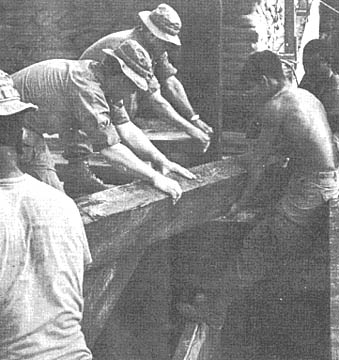 |
BRAVO BUNKER builders of the 65th Engineers muscle beams supporting a reinforced roof in a fire support center project. (PHOTO BY SP4 GARTH FIKE) |
Ask Sgt. Certain
DEAR SGT: We cooks are tired of hearing complaints
about the chow we serve. People are always accusing us of serving roast water
buffalo, powdered eggs left over from the War of 1812, stale cake with
salt-peter frosting, grease fried in bacon and other so-called jokes. We are
all GIs like everyone else; we love our mothers and go to Doris Day movies. We
are beginning to feel neglected. Please give us some advice.
PERSECUTED
DEAR PERS: I for one, have always felt Army chow
was really an advanced form of haute cuisine, and have tried for years to get a
few of the more outstanding mess halls listed in Duncan Hines' guide to good
eating. It's true that I once noticed "Size 11W" stamped on a piece of roast
beef I was eating at Fort Polk and another time ate a pancake that weighed nine
pounds at a Fort Ord breakfast, but in general I've found Army food to be the
best thing this side of White Castle. In fact, my wife used to be a WAC mess
sergeant, and I've come to enjoy having cold cuts and cheese for lunch every
eight days. The only thing I don't like is having to wash my plate in the
garbage can after every meal.
DEAR SARGE: As a soldier who works in the hold
baggage processing center, I'd like to make a complaint. Last week seven people
tried to send tanks home in their hold baggage. Four people brought in chinooks
wrapped in brown paper, two others wanted to send mortars and one asked if
there'd be any extra charge for sending the division swimming pool. Could you
tell people that they aren't allowed to send government property home like
that?
OVERWORKED
DEAR OVER: You're certainly right, and we hope this
will be sufficient warning to the despicable people who try to send things like
that. By the way, Over, do you think I will have to pay customs on my howitzer?
DEAR SERGEANT: Can you give me some hints about
keeping order in an EM club?
NCOIC
DEAR NC: This is a difficult but rewarding task.
First of all, remember that it is not a good idea to promise that you are going
to have a live show and then not have one. It is worse than not a good idea, in
fact, since you may face being beaten to death with beef jerky by disgruntled EM.
Also, try to prevent customers who are sure there must be one more Budweiser
there somewhere from diving into the beer cooler. And finally, in the event of
near-riot, think fast and yell, "Who said there were blank discharges being
given out at AG?"
Cavmen Take Over LCLC
CU CHI - The 25th Infantry Division's Lightning
Combat Leadership Course has all but become the 3d Squadron, 4th Cavalry's own
Non-Commissioned Officers Candidate Course recently.
Out of one recent group of seven graduating classes, the outstanding soldier
five times was a soldier from the 3/4 Cav, and each time he was rewarded with a
promotion from Specialist 4 to Sergeant.
Alpha Troop has had four of the LCLC stars, Sergeants Douglas Clapp of
Montreal, Canada, Richard Hagle of South Dayton, N.Y., Donald E. Master of Fort
Lauderdale, Fla. and Vernon Hallenbeck of Hudson, N.Y.
Captain Philip Hogue, of New Orleans, Alpha Troop commander, said: "We
select the personnel whom we think will best represent Alpha Troop and the
Squadron at LCLC, and we always hope to produce a graduate who finishes number
one in his class. An effort is made to send qualified personnel who have a
chance of excelling.
C Battery Earns Clan Cannon
TAY NINH - C Battery, 3d Battalion, 13th Field
Artillery (The Clan) received the coveted Clan Cannon quarterly award at
ceremonies at Tay Ninh base camp.
The red and yellow mini-cannon was presented by Division Artillery Commander
Colonel Dan D. Stedham to Captain Frederick A. Carroll of Pasadena, Calif., C
Battery commander.
The Clan Cannon is awarded quarterly to the battery within the battalion that
demonstrates the highest scores on over-all testing by the Clan's S-3 section.
Areas covered in testing include fire direction procedures, gunnery procedures,
speed and accuracy.
Shower Power
FSB Patton - Reminiscent of childhood hot
summers in the city, Fire Support Base Patton, home of the Fire Brigade's 2d
Battalion, 14th Infantry, has installed Vietnam's version of the open fire
hydrant.
The "shower power" system of eight high-pressure faucets offers welcome
relief to the overheated foot soldiers of the Golden Dragons.
"It's the next best thing to enamel bathtubs," commented Private First Class
Robert Barret. "We keep closer tabs on when the showers will be activated than
when chow is going to be served."
Water is supplied through two 55- foot wells.
"We'll never run out of water with these wells," said Private First Class
Albert Holden of Bronx, N.Y. operator of the shower.
The shower is turned on for half-hour intervals at 6 a.m., 3:30 p.m. and 6
p.m.
Deuces Improve Roads
TAY NINH - Cooperation on the part of many has
resulted in improved roads in Khiem Hanh District.
Heavy daily travel by armored personnel carriers of 2d Battalion
(Mechanized), 22d Infantry convoys and the rains have made smooth roads rough.
Captain Willie F. Black of Columbus, Ga., Triple Deuce S-5, coordinated efforts
through Tropic Lightning's First Brigade, and officials at Khiem Hanh District.
Laterite furnished by the 65th Engineer Battalion from Cu Chi was brought in
and unloaded by volunteers from Phuc Thanh refugee camp. Lien Van Buu, road
construction supervisor from Co Dau Ha, shows the people where the material is
to be unloaded and arranges coordination of people and material.
Black said, "When we help these people to help themselves they retain their
pride in themselves plus we show them how to improve themselves."
Page 7 TROPIC LIGHTNING NEWS November 3, 1969
Warriors Down 15 Near Hamlet
By PFC JIM WILLIAMS
CU CHI - With little sleep ahead of them, 2d
Battalion, 12th Infantry Warriors moved out with an ARVN Reconnaissance Company
on a night-early morning operation that resulted in 15 enemy killed, eight
detainees and an assortment of equipment and supplies.
The target of the operation was a village just south of the Boi Loi Woods
known to harbor VC and NVA troops and supplies of units based in the Boi Lois.
At approximately 10:30 pm, the Reconnaissance Company of the 8th Regiment,
5th ARVN Division proceeded northwest across Highway 6-A and then north along
the road. Shortly thereafter, Bravo and Charlie Companies of the Warriors moved
out of Fire Support Base Pershing to the north along the east side of the road,
all three units converging on the target soon after midnight.
The Reconnaissance Company set up a series of ambushes to the west of the
village, and Charlie Company set up to the east of the village near Highway
6-A. Completing the U-shaped formation was Bravo Company, which acted as a
blocking force to the north, cutting off any escape routes from the village
north into the Boi Loi Woods. With the stage set, the long vigil began.
The allied soldiers didn't have to wait very long, however. Shortly after
2:00 am, three enemy soldiers were spotted by Bravo Company; they alerted
Charlie Company by radio.
Private First Class Ken Kneeland of Shelton, Wash., described the scene:
"Bravo spotted three VC moving south on 6-A. They called us and we blew an
ambush on them. Soon after the first ambush was sprung, the ARVN Reconnaissance
Company spotted more individuals moving in the area. Opening fire, they killed
three, detained two suspects and captured four AK47 rifles.
Later in the morning, Charlie Company spotted three more enemy soldiers,
killing all of them and confiscating one K-54 pistol and a quarter pound of
documents. Finally, under illumination, gunships moved in at approvimately 4:30
am, giving the target village everything they had and boosting the body count.
Only with the arrival of sunlight could the damage wrought by the gunships be
assessed. Three hootches were nearly leveled, with heavy damage to several
others. Hutchinson commented, "We made a complete search of the area and found
supplies and gear."
| FUTURE ARVN - Two artillerymen from the 7th Battalion, 11th Artillery, Private First Class Gary Richardson of Upland, Calif. (left), and Specialist 4 Jimmy Jewell of Baker, La., put this young Vietnamese boy through drill and ceremony training during a break in firing at the Special Forces-CIDG Camp at Thien Ngon. (Photo by SP5 Pete Freeman) |
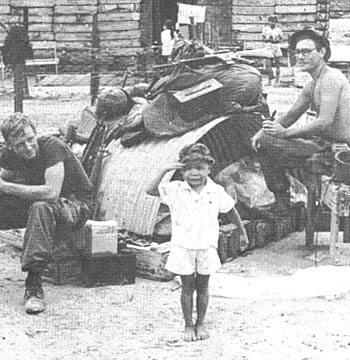 |
Tired Troops Down 12 VC
The Fire Brigade Company was thinking of showers and hot chow on its way to
the pickup zone at the end of a long mission. The enemy, though, was not yet
ready to call an end to the day.
Delta Company, 2d Battalion, 14th Infantry began to receive fire from a
tunnel complex in the Ho Bo Woods.
"The third platoon opened up and then the company swept the area," said
Private First Class Mike Hansel of Mt. Vernon, Ky.
The battle was short-lived, and all that was required to end it was the fire
from the company's small arms.
A search of the site afterwards revealed five enemy dead and four AK-47
rifles captured. Earlier the company found seven fresh enemy bodies near Patrol
Base Hunsley.
Manchus Trip NVA in Boi Loi
By SP4 RICHARD W. SEARS
TAY NINH - Night owls of Bravo Company Manchus
killed 14 NVA soldiers in springing two night ambushes in the dense jungle of
the Boi Loi Woods 25 miles southeast of Tay Ninh.
On the first night of a four-night operation, the 4th Battalion, 9th Infantry
soldiers, working with the 2d Battalion, 22d Infantry, broke into four separate
elements as they left Fire Support Base Wood.
Soon after nightfall the enemy was spotted.
Sergeant Dennis Theesefield of Armstrong, Iowa, recalled: "Eight of the
little men walked right into the first platoon's ambush."
Claymore were blown and hand grenades thrown, leaving five enemy dead.
"I saw the other three crawl away into the woods," added Private First Class
Eugene Kininock of Anaheim, Calif. "They looked as though they were hit pretty
bad."
Artillery support slammed an end to the firing, but at dawn the Manchus found
five NVA bodies.
Next night the scene was played again.
"We put out everything we could right on top of Charlie and then had to wait
until morning to see what happened," said Specialist 4 Elmon Harmon of Lizella,
Ga.
When daylight came, the Tropic Lightning soldiers moved to the previous
night's target area.
"We could see a lot of them lying in the open, not moving, when the sun came
up," remembered Private First Class Paul T. Walla of Gary, Ind.
There turned out to be nine more enemy KIA, making a two-night total of 14
against not even a dust-off for the Manchus.
1st Wolfhounds Man Marshes:
Recon Guards Duc Hoa
By PFC FRANK REZZONICO
DUC HOA - The fast-moving reconnaissance platoon
of the 1st Battalion, 27th Infantry Wolfhounds is continuing to build on its
reputation as a crack combat-ready unit in the marshy area of operations of the
3d Brigade.
Under command of First Lieutenant Patrick Smith of Madera, Calif., the
platoon operates out of Duc Hoa in Hau Nghia Province.
Coordinating operations with the First Wolfhounds and the District Chief at
Duc Hoa, the platoon's mission encompasses local and long-range reconnaissance
as well as the ultimate destruction of the Viet Cong and North Vietnamese
infiltrators in the area.
OPERATIONS RELY heavily on the unit's four jeeps
that are equipped with .50 caliber and M-60 machine guns. With them the platoon
tears into terrain that most units reach only by air.
When the words "saddle up" are sounded, each man moves to an assigned jeep
and within minutes the platoon is ready for action. In one recent action, the
alarm was sounded and within a half hour, the team had moved ten kilometers to
set up a blocking force and check civilian identification in a remote hamlet.
Occasionally the mud and water are too thick and deep even for recon's
jeeps. In a recent outing to locate an enemy weapons cache and bunker complex,
the platoon's members dismounted and charged the last 500 meters through the
swamp.
THE WOLFHOUND reconnaissance platoon has been
working out of Duc Hoa for three months. Their camp site was a mud-covered area
of decayed bunkers and poor security when they arrived.
Under the direction of Smith and Sergeant Richard Kittrell of Layton, Utah,
the area has taken a new form. A mess hall, sleeping quarters, shower
facilities and new bunkers have been built. A club and additional sleeping
quarters are under construction.
Private First Class Mark Oizerowitz of Lakewood, N.J., is a prime example of
the spirit of the First Wolfhound reconnaissance platoon. He says, "If I had a
chance to join any infantry unit in Vietnam, it would be this one."
Cav Kills 7, Finds Hospital
By SGT TONY CAMELIO
CU CHI - Operating 15 miles northwest of Cu Chi base
camp in the area known as the Country Store, the men of Bravo Troop, 3d
Squadron, 4th Cavalry uncovered a small hospital complex and killed seven
soldiers.
First Lieutenant Charles A. Shaw of St. Louis, Mo., 3d Platoon leader said,
"We were heading north on a reconnaissance-in-force mission to the Boi Loi Woods
when we had a change of mission. A Delta Troop light observation helicopter (LOH)
had killed two Viet Cong and spotted a bunker complex in the Country Store area
and we were sent in to check it out."
"Upon reaching the area we put our dismounts down and started checking out
the holes, when suddenly people started running out of holes to our front in all
directions," continued Shaw. "The quick reactions of our dismounts when they
saw these people running from the holes resulted in seven enemy soldiers being
killed."
A further check of the area revealed a small tunnel complex with three
interconnecting large rooms, and a large quantity of medical supplies. The
complex was believed to be a Viet Cong convalescent hospital.
Grants Given
Applications are currently being accepted for the Army ROTC four-year
scholarship program. The program is open to personnel who are scheduled for
separation prior to the 1970-71 school year and who will enter college as
freshmen during 1970.
The program is aimed at personnel who are seriously considering careers as
commissioned officers. Assistance and information is available through the AG
Personnel Actions Branch in Cu Chi.
| SPLISH SPLASH - Men of the First Wolfhounds' reconnaissance platoon trudge through a swamp near Duc Hoa in the 3d Brigade area of operations. Marshy spots are nothing new to the recon team. Most of the Duc Hoa area is under water during monsoon season. (Photo by PFC Frank Rezzonico) |
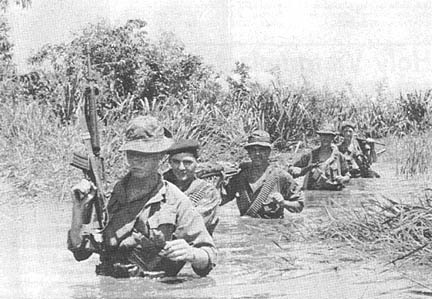 |
Page 8 TROPIC LIGHTNING NEWS November 3, 1969
VC's War: No Mail, No DEROS, No Hope
(Continued From Page 1)
Base camp discipline was harsh. Small talk or casual conversation was
strongly discouraged. A VC cadreman told Tri and his group when they first
arrived that if they did anything wrong, they'd be executed. Tri never saw this
policy carried out, but often saw comrades publicly beaten by the VC equivalent
of MPs for no apparent reason.
ONE OF THE biggest problems his unit faced was a
lack of supplies. The only medical supplies available were malaria pills that
caused cramps and diarrhea. Rather than suffer the ravages of that weekly pill,
most of Tri's companion's simply refused to take them. (Consequently, more than
50 per cent of the Communist forces suffered recurring spells of malaria and as
many as 20 per cent died during peak malaria seasons.)
Tri's clothing issue for his two-year tenure with the enemy consisted of two
pairs of fatigues, one set of underwear and a pair of sandals. His salary was
80 piasters - 68 cents - a month. He never received mail.
More than two months of Tri's time were spent at political indoctrination
courses, but much of the theory was lost on him since he could not understand
the thick dialect of his NVA instructors.
TACTICALLY, THE Communist soldiers were told to
avoid daylight contact with American forces unless they outnumbered the GIs at
least two to one.
Tri also said he was taught that if his unit came under gunship attack, it
should hold its ground while flanking units scattered into the brush. If they
threw up enough fire, Tri and his companions were told, they would scare off the
minigun-packing choppers.
Tri didn't see much future in his military career, so when he was selected
for a 30-man advanced infiltration party bound for the Boi Loi Woods, he
defected - encouraged by a PSYOPS chopper that was advertising the Chieu Hoi
Program and a gunship that had strafed his unit. An additional persuasion was
the memory of four B-52 bombing raids in five nights that wiped out 15 of his
friends.
TRI STUMBLED upon a Tropic Lightning patrol and
although terrified, surrendered and asked to join the Chieu Hoi program. The
Americans gladly complied.
After being reunited with his family, Tri said he'd like to get his fields
back in order and then join the ARVNs.
Life among the VC/NVA officer corps is hardly any more attractive. VC
Captain Tran Minh Dao was found in a spiderhole in the Boi Loi Woods by troopers
of Company B, 2d Battalion, 14th Infantry. He chose that opportune moment to
rally to the government and has since provided Allied forces with some valuable
information and insights into life with the enemy.
A PROFESSIONAL soldier who helped drive the
French from Indo-China in 1954, Dao went to Hanoi and Red China for advanced
military training, with emphasis on guerrilla tactics. But he was relieved of
his command and drummed out of the service in 1960 when he protested land
reforms that included the shooting of hundreds of private landlords.
In 1967, North Vietnam needed soldiers - regardless of politics - so Dao was
commissioned again and sent on the five-month journey down the Ho Chi Minh trail
into Tay Ninh Province with a unit of NVA regulars. He had been away from
military training for more than seven years.
Dao served as the senior captain of the combat tactics section of the VC's
Sub-Region 1 northwest of Saigon and as regimental executive officer of the
Quyet Thang Regiment. He received a monthly 120 piasters - $1.01 - plus 15
piasters a day to buy food.
Dao said that NVA forces in South Vietnam are tired of the war. The NVA
soldier has no DEROS day, no leaves to return home and very little mail. He has
seen many of his comrades killed and must wonder about his own chances.
TO COMBAT these problems, Dao said, discipline
with the enemy units is extremely strict. Disciplinary problems are often shut
up in small cages for prolonged periods of time.
Dao has great respect for the Tropic Lightning soldier. He said the 25th is
the best American fighting unit he has come up against. He said his men seldom
tried to beat the Americans in the field. Instead, he hoped the Americans would
hurt their own cause by disregarding the customs of the Vietnamese. His men
were ordered always to treat the villagers politely and never to appropriate
food.
This, he said, is where the war will be won or lost.
Warriors Lead Rout of Enemy
Mushroom Is Poison, NVA Find
(Continued From Page 1)
PRIVATE FIRST Class Lonnie Bruce Wagner of
Hawthorne, Nev., added: "Once we were in there, everything was up to us. We
couldn't ask for air strikes anymore. We were taking fire from every
direction. At times the enemy was right in between us and we couldn't fire for
fear of hitting our own guys. We just kept firing until we could get out."
Again the Tropic Lightning soldiers pulled back and called for fire support
and again the early evening sky exploded with air strikes, artillery and
gunships.
Stingers from the 116th Assault Helicopter Company swept across the marshy
plain that lies on the other side of the river and dropped a curtain of machine
gun fire across the enemy's only possible escape.
"CLOSE? YES, it was close," said Lieutenant
Colonel Burton Walrath of Arlington, Va., Warriors' commander. "It was toe to
toe. They were a stubborn outfit, recently trained and well equipped. They
intended to stay."
With a platoon from Charlie Troop, 3d Squadron, 4th Cavalry and elements of
the 2d Battalion, 14th Infantry Golden Dragons, the infantrymen swept again with
guns blazing and artillery in close support.
Tropic Lightning had apparently encountered a supply and assembly point where
recruits were being trained to replace the nearly 800 enemy lost to Tropic
Lightning in this area since July. If the VC wished to keep the real estate,
the Warriors, the Golden Dragons, and the Cav. intended to exact a very high
price.
AFTER A LAST feeble effort to resist, the
remaining enemy broke contact and fled toward the Saigon River.
In the immediate area, 47 enemy dead were found as the allied soldiers
circled into a night laager position. Nine U.S. soldiers had been killed in
action and a major enemy position decimated. It was not a position the 25th
Division intended to give up easily.
Cobra Saves Downed LOH Teammates
By SGT TONY CAMELIO
and
SP4 JOHN HAYDOCK
CU CHI - Under circumstances that seemed like
the script for an adventure movie, three men of Delta Troop, 3d Squadron, 4th
Cavalry found themselves in a frying pan of fury, but scrambled out and put an
enemy base camp into the fire.
While investigating Alpha readings - indications from "people-sniffers" that
enemy is nearby - a Light Scout Team, an LOH helicopter and Cobra gunship, were
hovering over a dense section of the Ho Bo Woods.
Suddenly the low-flying LOH received fire. The pilots, Captain Thomas J.
Sinclair of San Carlos, Calif., and Captain Wayne A. White of Columbus, Ga.,
were both hit in the leg. The LOH faltered, hit the ground and rolled over on
its left side.
Immediately, Specialist 5 Charles P. Vierra of Providence, R.I., the LOH's
crew chief, pulled the two wounded men from the downed craft and helped them to
safety in a nearby bomb crater, despite a hail of enemy small arms fire.
White later recalled, "I thought we could stay by the LOH, but when I saw the
dust raised by the incoming fire and heard a lot of excited talking in the
bushes, I felt much safer moving out of the area."
Vierra returned to the aircraft, took out his M-60 machinegun and ammo, and
set up a 180-degree field of fire facing the enemy.
Meanwhile, Sinclair had struggled from the crater, found a landing zone about
20 meters away and waved the Cobra in for a landing.
The VC were screaming and rushing the area, but the Cobra touched down after
blasting the enemy positions with rockets to back up Vierra's continuing fire.
The Cobra pilot, Captain William Malinovsky of Columbus, Ohio, said, "I knew
it was a chance to pick them up, but it was a better one than they had down
there with wounds."
Warrant Officer 1 Larry E. Bruce of Richfield, Minn., leaped from the Cobra
and helped Sinclair unfasten the ship's doors and free the ammo pods.
While the wounded men were hustled into the gunship, Vierra kept up his
suppressive fire until he ran out of ammunition, and by that time everyone had
been loaded onto the Cobra. It took off, carrying three hits it absorbed while
on the ground and leaving the suprised enemy for Fire Brigade infantrymen.
They arrived soon in the person of Bravo Company, 2nd Battalion, 14th
Infantry. A four-ship lift brought the company's third platoon to the scene of
the crash and its first platoon soon arrived to link up.
The Golden Dragons moved quickly into what turned out to be a VC base camp.
The LOH was lying on its side, expended AK ammo scattered all around. The
Tropic Lightning troops formed a 360-degree perimeter and began searching the
area, soon finding a vast tunnel complex.
The Dragons found a small cache, but the VC had fled. The Americans stayed
around long enough to secure the area while a Huey UH-1 came in to lift the
downed LOH out of the area.
Sinclair, Bruce, Vierra and Captain William E. Malinovsky of Columbus, Ohio,
commander of the Cobra who made the decision to land and then used his sidearm
to help hold the enemy at bay, all received Silver Stars for their part in the
action. White was a awarded a Distinguished Flying Cross. The five awards were
presented in ceremonies the day after the incident.
| SAME-SAME - Beginning their daily road clearing reconnaissance on Highway 7A, Bobcats of the 1st Battalion (Mechanized), 5th Infantry get ready to battle the mud. (PHOTO BY PFC RICH FITZPATRICK) | 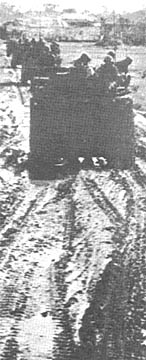 |
Holy Vietnamization! ARVN-GI Duo Prevails
By SP5 TONY DeBLASIO
CU CHI - Like the Joker, The Penguin and the
Riddler, the Viet Cong have all learned the hard way that it just doesn't pay to
fight Batman.
This time, "Batman" was in the form of the 8th Reconnaissance Company of the
8th Regiment, 5th ARVN Division, whose men sport pictures of Batman over their
right shirt pockets.
The Batmen have been working with the Warriors of the 2d Battalion, 12th
Infantry. Recently they conducted a night bushmaster south of the Boi Loi
Woods.
The ARVNs sprang their ambush four times during the night. On the way to
their AP site, a hasty ambush was set up when Viet Cong were spotted a few
meters in front of the Allies. Again and again the Vietnamese set up to spring
their AP on the unwary enemy.
A sweep of the area the next day found the effects of their night's work:
eight VC killed, two detainees, two prisoners of war, ten pounds sugar and 100
pounds of cooking utensils.
As a result of their actions during the busy night, the ARVN soldiers were
awarded Bronze Stars and Army Commendation Medals from Tropic Lightning
Commander Major General Harris W. Hollis. General Hollis, who presented the
awards at Fire Support Base Pershing, told the ARVNs: "You're doing a fine job.
Keep up the good work."
Thanks to:
Karl Karlgaard, 2nd Bn., 27th Inf., and a Tropic Lightning News correspondent,
for sharing this issue,
Kirk Ramsey, 2nd Bn., 14th Inf. for creating this page.
This page last modified 01-29-2005
©2005 25th Infantry Division Association. All rights reserved.